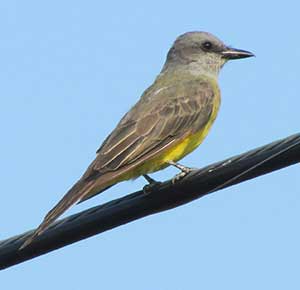
After reading reports (and writing about) the Tropical Kingbird currently visiting Dayton, Maine, the authors decided to make the trip to see the bird themselves. (Photo courtesy of Jeff Wells)
We’d been hearing about a pretty cool bird lately that appeared in the unlikely town of Dayton, Maine. The bird, a Tropical Kingbird, which has very few records for Maine, is both beautiful and intriguing, and so we wrote about it in our weekly column in the Boothbay Register (you can read that particular column here). This past weekend, we found ourselves making the trek to see this rare visitor from the tropics.
With birds, you’re just as likely to strike out on seeing them as you are in actually seeing them, so off we went to Skelton Dam along the Saco River with few expectations.
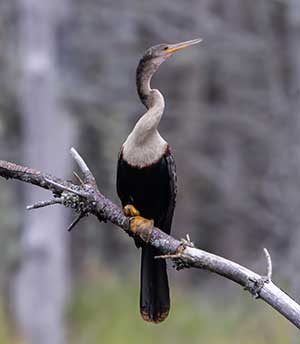
Imagine seeing this mysterious-looking bird in a beaver pond in Lincoln County, Maine. That’s where Maine’s first Anhinga was recently discovered. (Photo courtesy of Louis Bevier)
On such a beautiful sunny day, we weren’t surprised to find the boat launch parking lot packed with vehicles with boat trailers in tow. Clearly a great many people were out on the river enjoying the hot, summer day.
Luck was with us, though. First, we managed to find a parking space, and second, as we pulled into it, we spied the bird sitting almost above us on a telephone wire. One glance, and we knew it was the bird, with its classic kingbird shape and lemon-yellow undersides. It was almost too easy! Even as we stepped out of the car to get our binoculars, telescope, and camera from the back, the bird hardly moved from its perch.
Because the bird had been there much of the summer and was such a reliable find, most birders had apparently already made their trips to see and admire it, so we were the only ones there for the 30 minutes or so that we stayed. At one point, a man came off the water and asked us if we were flying a drone! When we told him what we were doing, we were glad that he was interested in this third-ever Tropical Kingbird to visit Maine.
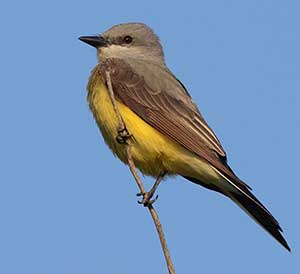
Another rare bird, a Western Kingbird, was recently seen at the site of the former Brunswick Naval Air Base. (Photo courtesy of Wiki Commons)
Soon after we wrote about this bird for our Boothbay Register column, we received word that an even more astonishing bird from down south had been found in the state. It was Maine’s first-ever Anhinga! For its long, winding neck, the Anhinga is sometimes known as the snakebird or the water turkey. Some would describe it as a prehistoric-looking bird, like a cormorant whose neck and tail have been stretched. We’ve seen many Anhingas in Florida where they are resident. But they breed regularly only up to coastal North Carolina and across to Texas. Their normal range extends south from there through Mexico and Central America and in South America south to Argentina.
The odd birds continue.
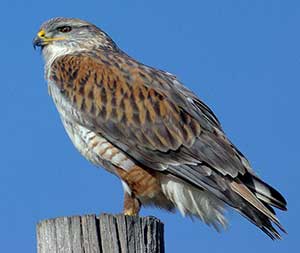
A Ferruginous Hawk, like this one, is a species of the western US. It had never been recorded anywhere in New England until this past July, when one was found in Maine. (Photo courtesy of Alan Schmierer)
A few days after the Anhinga was reported, a Western Kingbird was found and photographed at the former Brunswick Naval Air Base. Interestingly, the Western Kingbird has yellow undersides like its tropical cousin, but is a smaller bill, has different vocalizations, and has a few other distinguishing factors as well. The closest the species nests is in Minnesota. Small numbers do show up in fall migration here in Maine but not normally in summer. Oddly enough, another was photographed way out on Mount Desert Rock in June.
All of these vagrant birds were preceded by another Maine first: a Ferruginous Hawk, found in mid-July at the Lewiston-Auburn airport. This was not only a first for Maine, but apparently a first for all of New England!
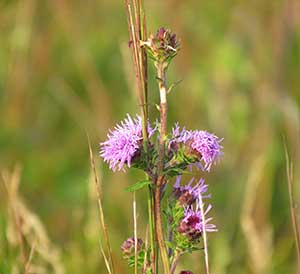
During a recent visit to the Kennebunk Plains, the authors saw an early northern blazing star, a rare, native flower that in August will turn this protected area purple. (Photo courtesy of Jeff Wells)
After spending time with the Tropical Kingbird last weekend, we continued on to one of our favorite places, the Kennebunk Plains. We spent many summer days here back in the 1980s and 1990s conducting research that helped lead to the place becoming protected. We have very fond memories of seeing and hearing some amazing birds and learning about the cool plants and insects that live here as well. Late on this beautiful summer day, it was glorious to be among the golden grasses, green shrubs, and the occasional early flowering northern blazing star in its purple glory. With the breeding season largely over, there weren’t a lot of birds evident—some Field Sparrows, Bobolinks, Eastern Bluebirds, Eastern Towhees.
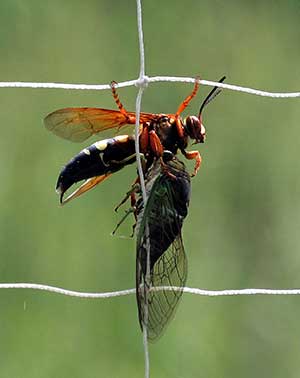
This large wasp parasitizes cicadas. The authors found one on the Kennebunk Plains while looking for birds. (Photo by Bill Buchanan, U.S. Fish and Wildlife Service. Courtesy Wikimedia Commons)
As we poked around, it wasn’t a bird that really piqued our curiosity here this time. It was an insect that we had never seen before. It was large and buzzed loudly. We couldn’t be sure if it was a type of moth or hornet or something entirely different. We did what you can in those situations: attempted to procure some photos and video.
Later, we were able to upload a photo into iNaturalist and discovered it was something called an eastern cicada-killer wasp. Just like its name suggests, it captures cicadas, paralyzes them, and puts them into a burrow dug in the sand. It lays an egg in the burrow, and once the egg hatches, the larva eats the cicada. You can rest easy knowing that despite their large size and appearance, eastern cicada-killer wasps are harmless to humans—they don’t have a protective stinger. We had never seen one of these cool creatures before, and in iNaturalist, we didn’t find any Maine records prior to 2019. If there is an entomologist out reading this, maybe you can tell us if they are indeed a new arrival to Maine or if they have always been here.
All of these vagrant birds and a weird bug to boot. It got us wondering, what’s next?
—Allison and Jeff Wells











Thank you! for such an interesting article.
Glad you enjoyed the piece!